openapi: '3.0.2'
info:
title: Multi-server Cemo API
version: '1.0'
servers: (1)
- url: https://{customerId}.saas-app.com:{port}/v2
variables:
customerId:
default: demo
description: Customer ID assigned by the service provider
port:
enum:
- '443'
- '8443'
default: '443'
- url: https://{region}.api.company.com
variables:
region:
default: westus
enum:
- westus
- eastus2
- westcentralus
- westeurope
- southeastasia
- url: https://api.company.org/data/2.5/
description: Production server
- url: http://beta.api.company.org/data/2.5/
description: Beta server
paths:
/default:(2)
description: A default path to the API
get:(3)
summary: "The get method for /default"
responses:
200:
description: Successful response
/duplicated:(4)
description: Has some of the default servers
servers:
- url: https://api.company.org/data/2.5/
description: Production server
- url: http://beta.api.company.org/data/2.5/
description: Beta server
get:(5)
summary: "The get method for /duplicated"
responses:
200:
description: Successful response
/files:(6)
description: File upload and download operations
servers:
- url: https://files.example.com
description: Override base path for all operations with the /files path
get:(7)
summary: "The get method for /files"
responses:
200:
description: Successful response
/ping:(8)
servers:
- url: https://endpoint.example.com
description: Override base path servers
get:(9)
servers:
- url: https://echo.example.com
description: Override base path for the GET /ping operation
- url: https://echo2.example.com
description: Also overrides base path for the GET /ping operation
summary: "The get method for /ping"
responses:
200:
description: Successful response
post:(10)
summary: "The post method for /ping"
responses:
201:
description: Successful create
Differences for OAS 3.0 in Rendered Documentation
The right pane of the text editor in API Designer displays the documentation that is written into API specifications. Documentation is rendered identically for REST API specifications written in RAML or OAS 2.0. However, documentation for API specifications written in OAS 3.0 can include multiple server definitions as well as links and callbacks.
Documentation for Definitions of Multiple Servers
OAS 3.0 enables you to define servers by using the servers field. You can define servers globally at the top of a specification, locally for endpoints, and locally for methods. Local definitions override the definitions set at the next higher level in the specification’s hierarchy. Definitions set locally for methods override definitions set at endpoints and globally. Definitions set locally for endpoints override definitions set globally.
The following example API specification demonstrates different ways, indicated by ten callouts (1-10), that you can set server definitions. After the example API specification, the documentation for the portion of the API at each callout is illustrated with a screenshot.
-
The Summary page of the documentation for this API lists the four servers that are defined in this
serversfield: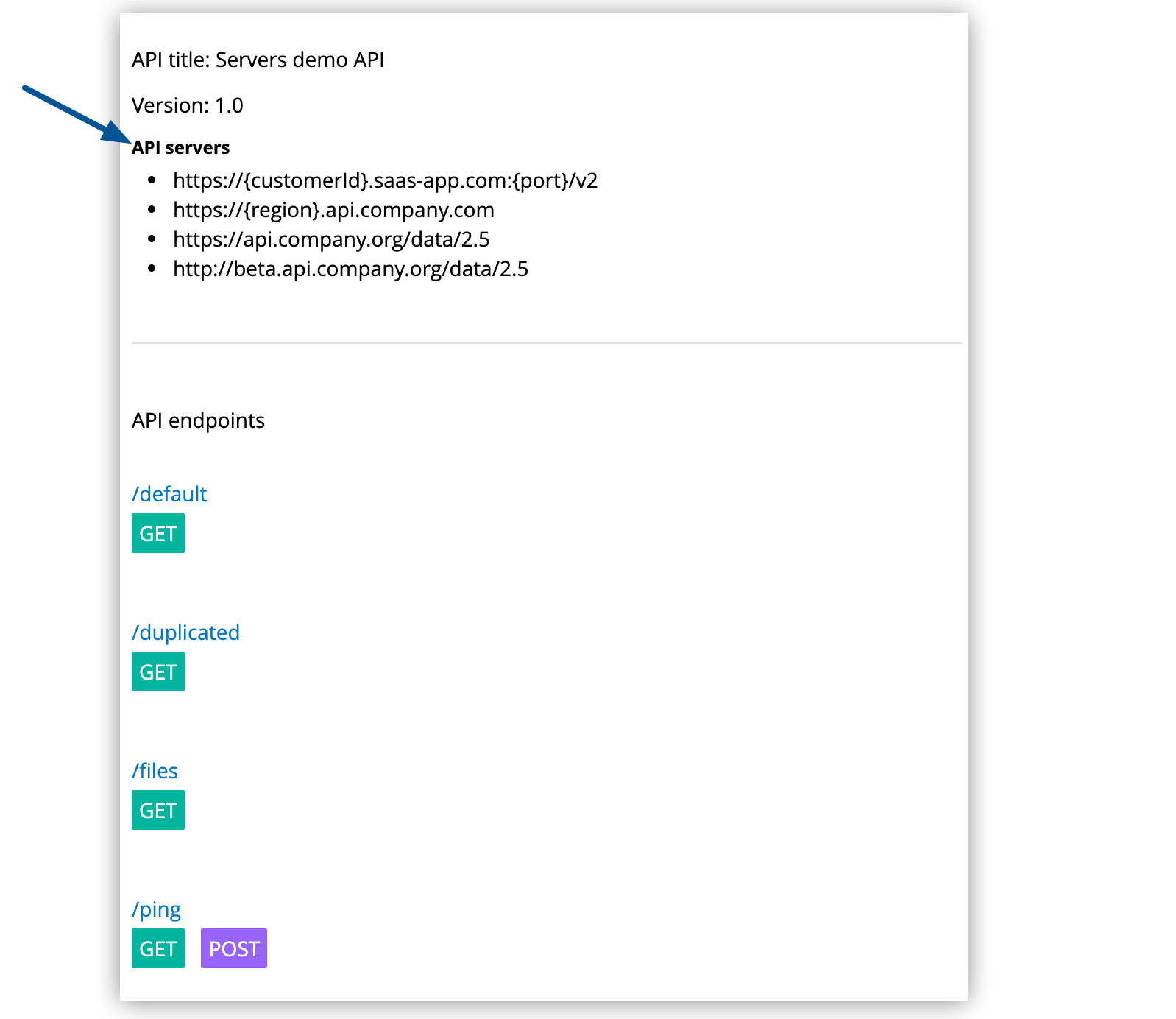
-
The
/defaultendpoint does not override the baseserversdefinition at the top of the API. On the Overview page for the endpoint, you can select a server to see the URI for this endpoint at that server: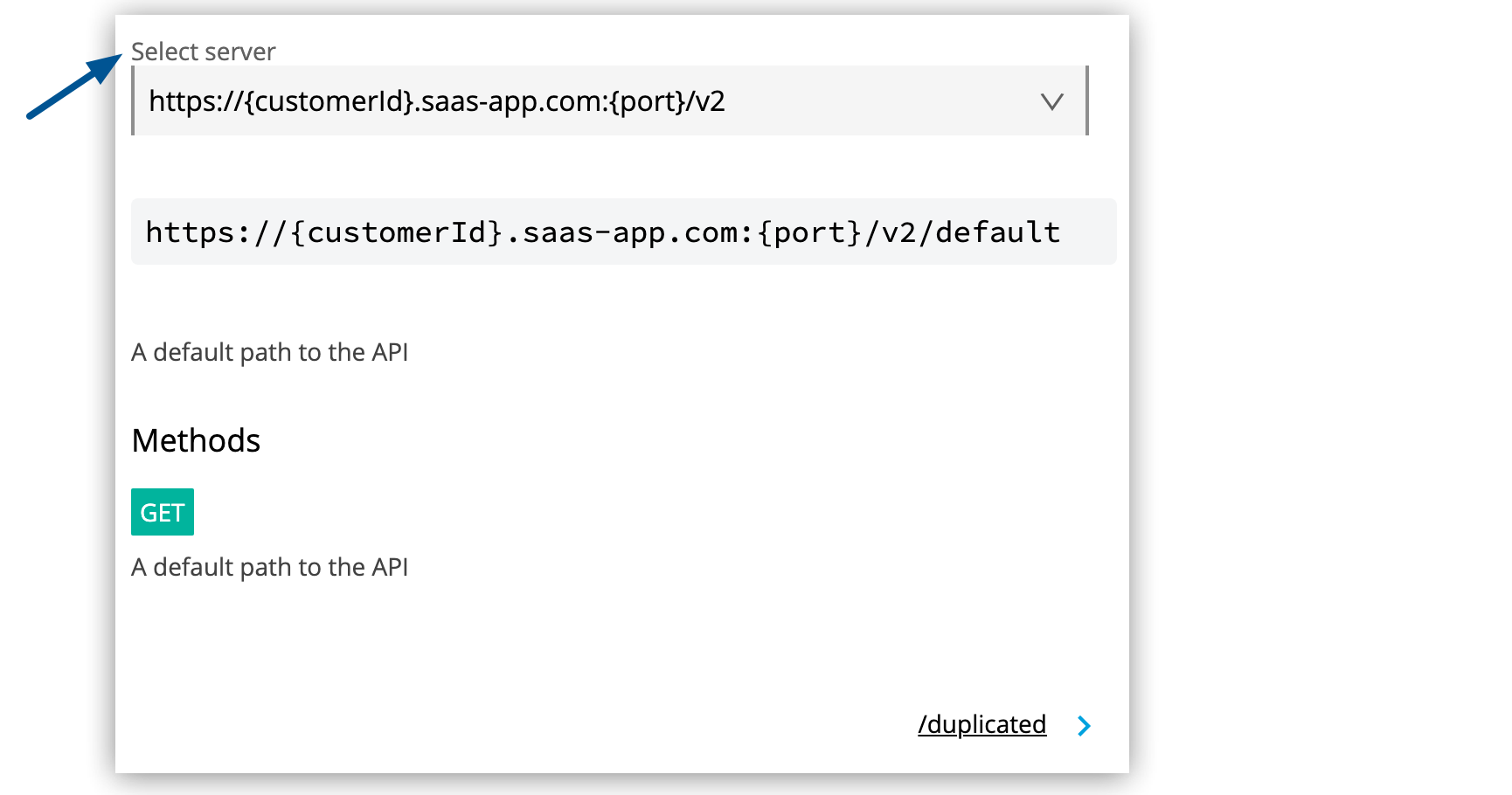
-
The GET method for the
/defaultendpoint also inherits the four servers in the baseserversdefinition. On the page for this method, you can select a server to see the URI for this method at that server: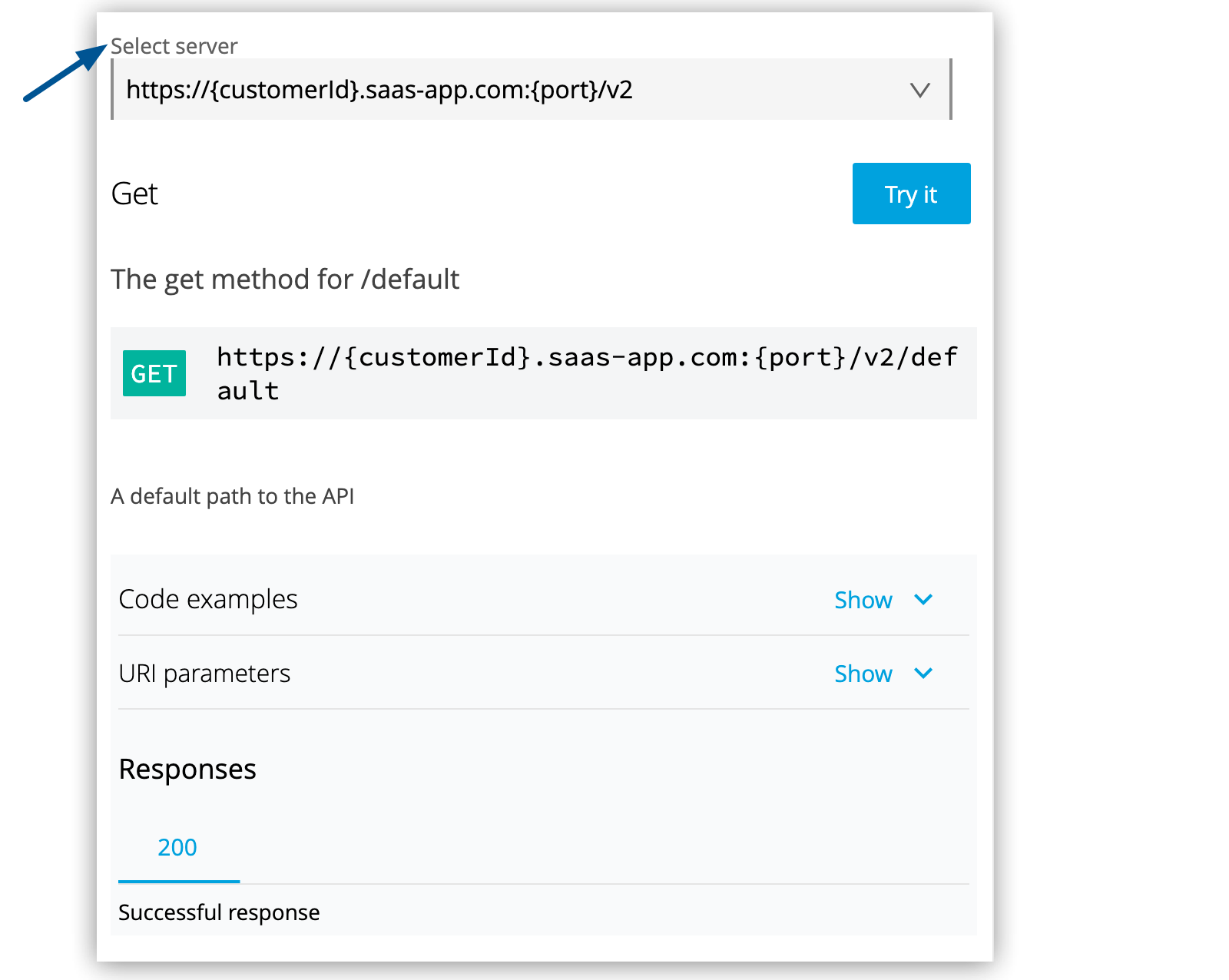
-
The
/duplicatedendpoint overrides the baseserversdefinition, its localserversdefinition including only the last two servers of the original four. On the Overview page for the endpoint, you can select a server to see the URI for this endpoint at that server: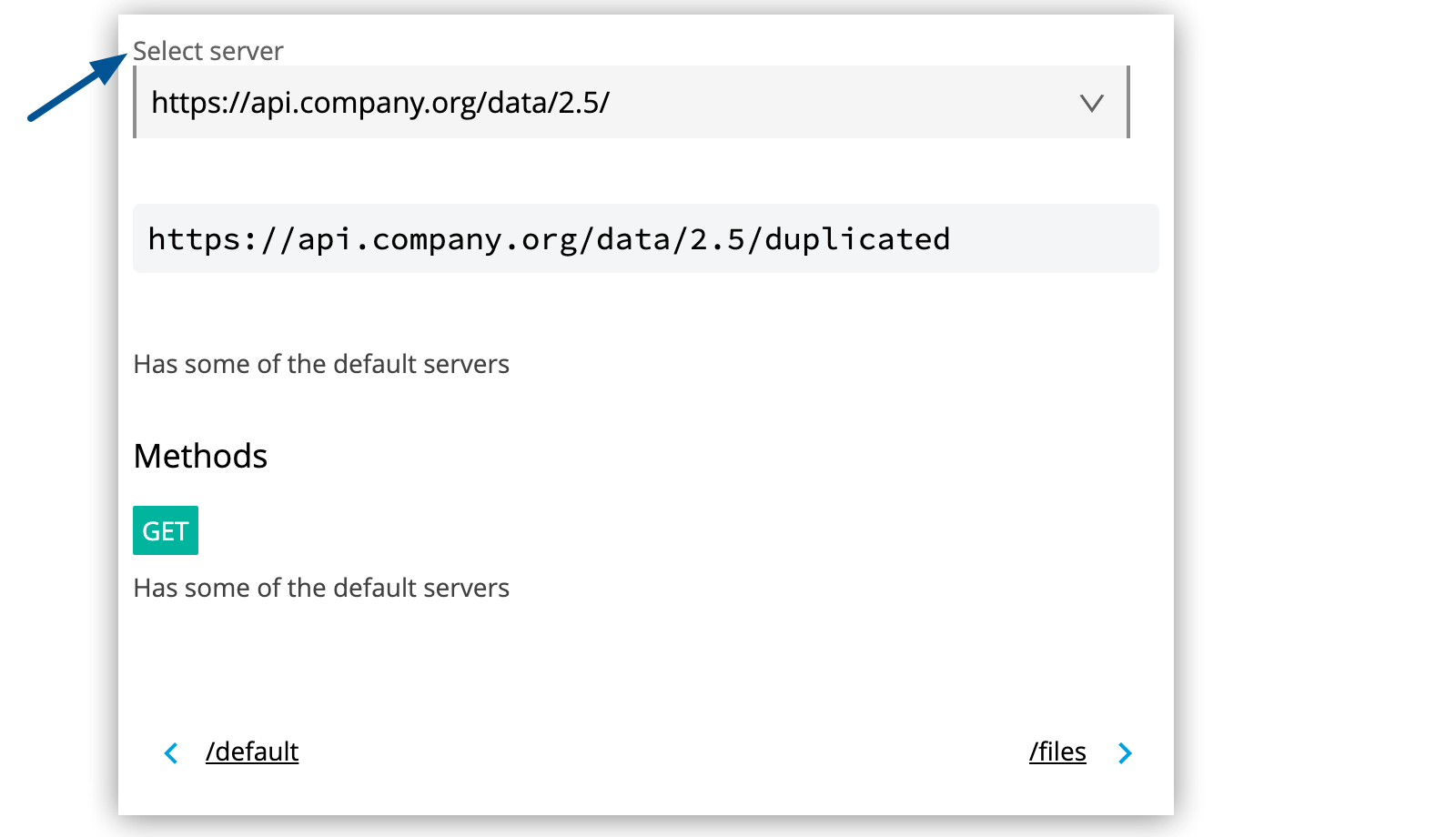
-
The GET method for the
/duplicatedendpoint inherits the two servers in the localserversdefinition. On the page for this method, you can select a server to see the URI for this method at that server:
-
The
/filesendpoint overrides the baseserversdefinition, its localserversdefinition including only one server. On the Overview page for this endpoint, there are no servers to choose from, as there were for the previous two endpoints:
-
The GET method for the
/filesendpoint inherits the one server in the localserversdefinition. On the page for this method, there is no list of servers to choose from: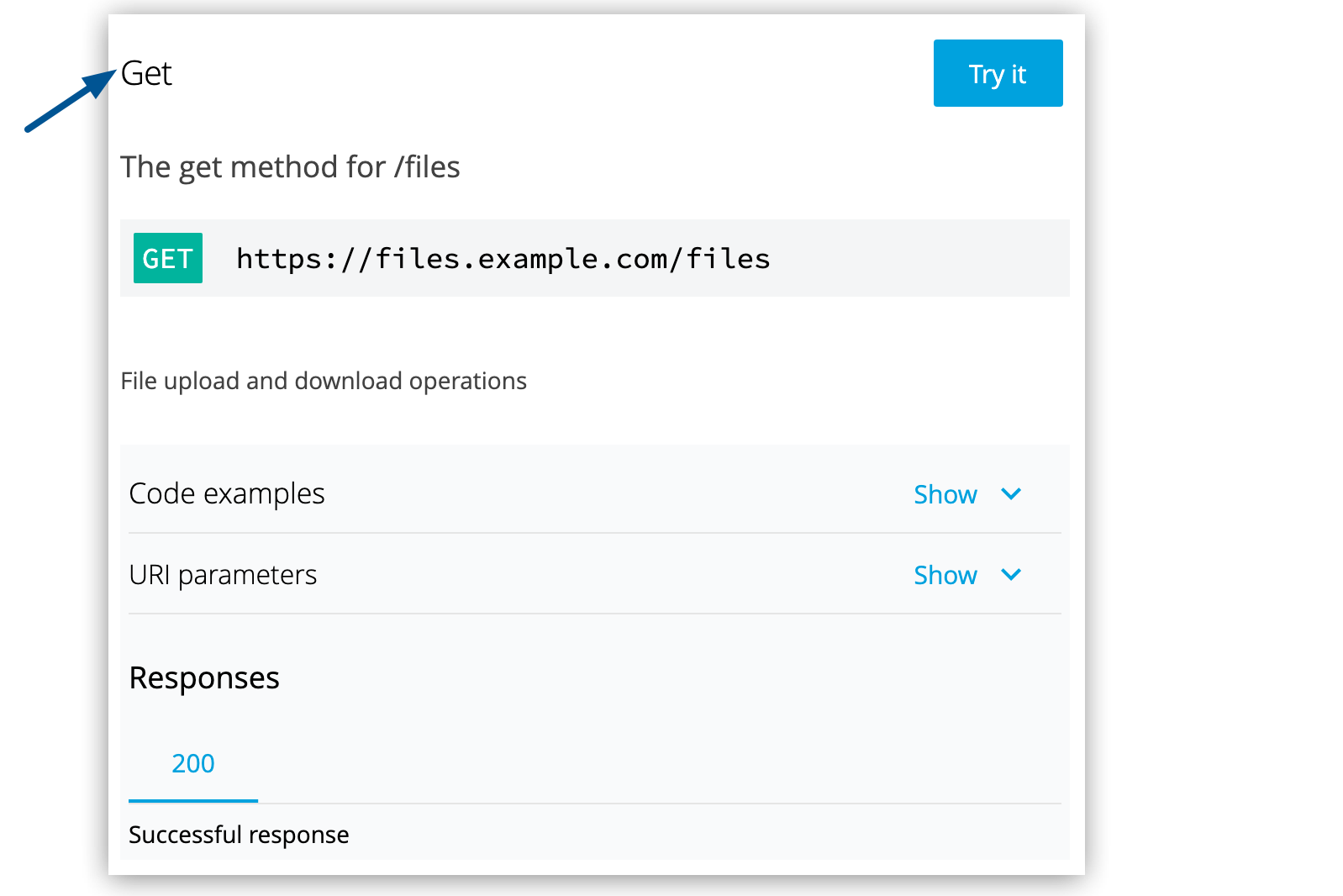
-
The
/pingendpoint overrides the baseserversdefinition, its localserversdefinition including only one server. On the Overview page for this endpoint, there are no servers to choose from: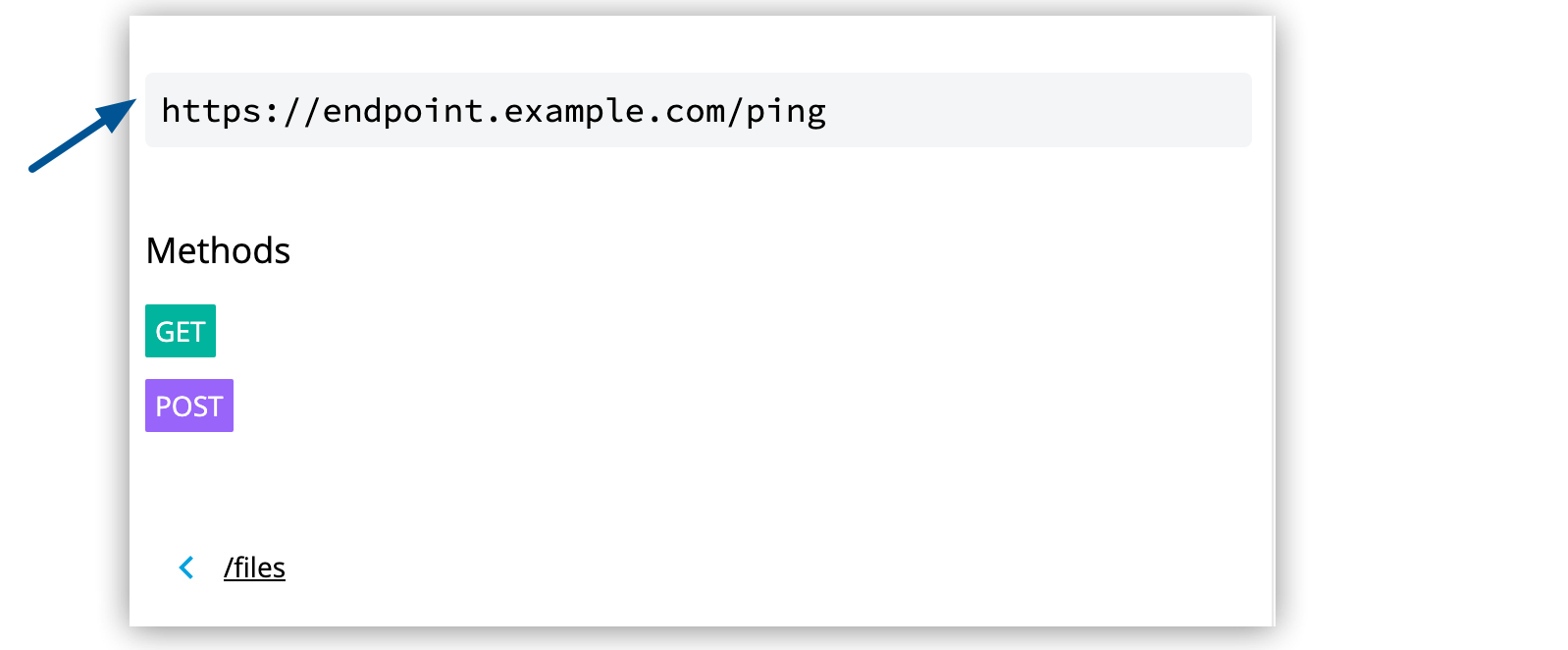
-
The
GETmethod for the/pingendpoint overrides both the baseserversdefinition and the/pingendpoint’s localserversdefinition. TheGETmethod’s localserversdefinition includes two servers. On the page for this method, you can select a server to see the URI for this method at that server: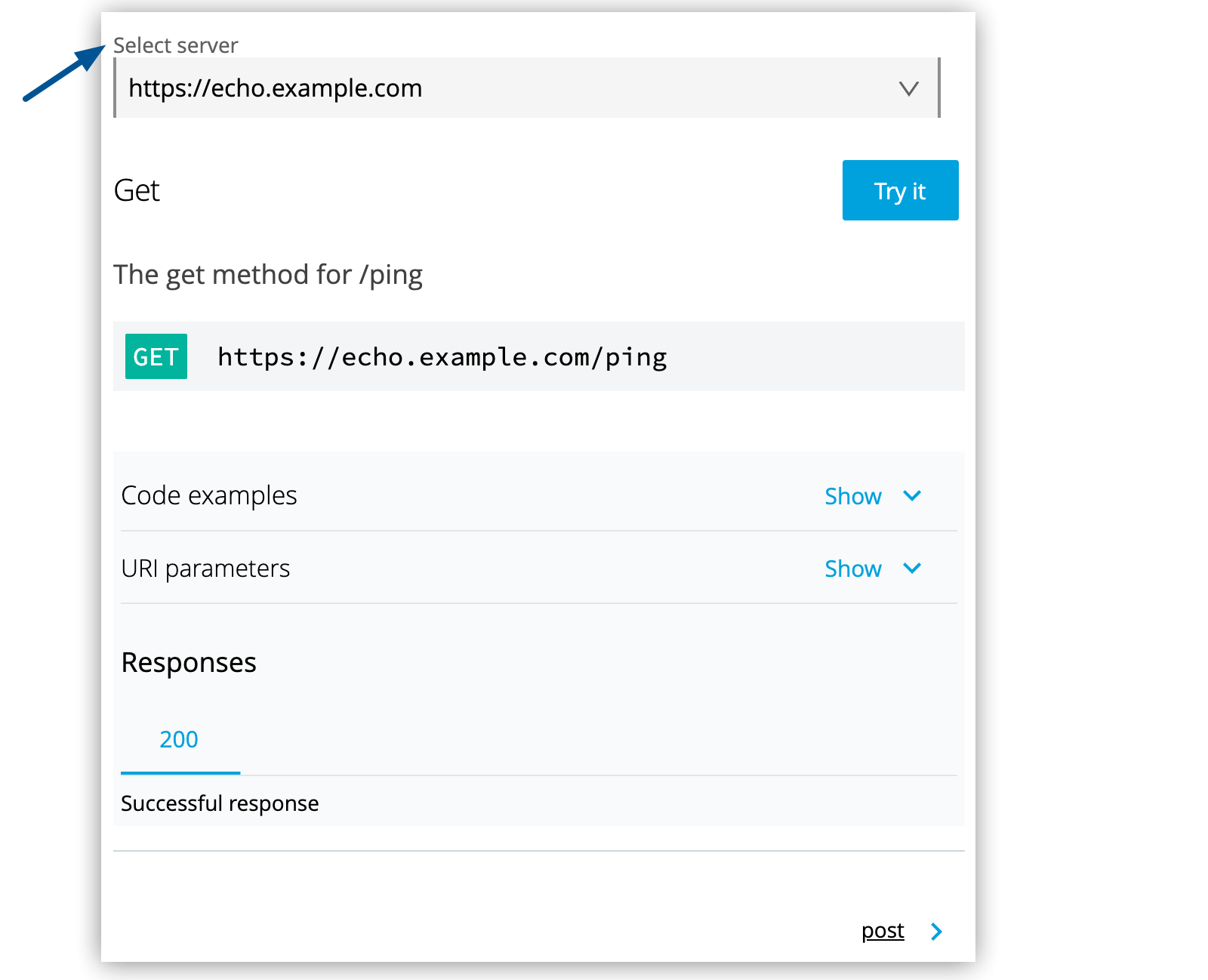
-
The POST method for the
/pingendpoint inherits the one server in the/pingendpoint’s localserversdefinition. On the Overview page for this endpoint, there is no list of servers to choose from: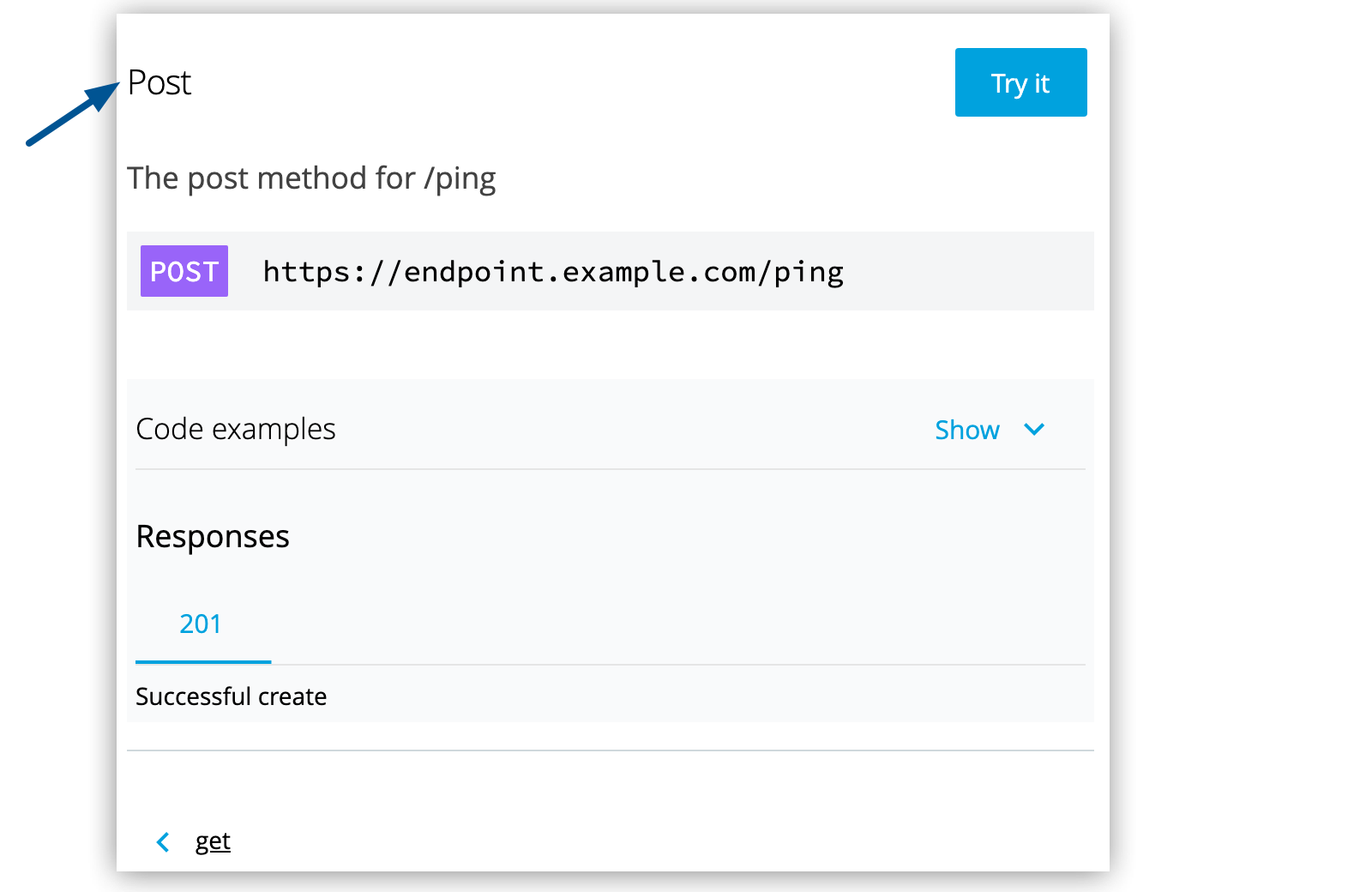
Documentation for Links and Callbacks
OAS 3.0 enables you to define links and callbacks. For an explanation of these features, see the specification for openAPI 3.0 at https://swagger.io/.
The following example API specification demonstrates how to set links and callbacks. The callouts indicate parts of the API specification that are rendered as documentation in the screenshots that follow.
openapi: 3.0.0
info:
version: 1.0.0
title: Callback Demo API
servers:
- url: https://{customerId}.saas-app.com:{port}/v2
variables:
customerId:
default: demo
description: Customer ID assigned by the service provider
port:
enum:
- '443'
- '8443'
default: '443'
components:
requestBodies:
callbackMessage1:
description: Callback message `1`
required: true
content:
application/json:
schema:
$ref: '#/components/schemas/Clb1'
callbackMessage2:
description: Callback message `2`
required: true
content:
application/json:
schema:
$ref: '#/components/schemas/Clb2'
callbackMessage3:
description: Callback message `3`
required: true
content:
application/json:
schema:
$ref: '#/components/schemas/Clb3'
schemas:
Clb1:
title: Event 1
type: object
properties:
text:
type: string
description: Message text
Clb2:
title: Event 2
type: object
properties:
productId:
type: string
description: Order product id
Clb3:
title: Event 3
type: object
properties:
eventId:
type: string
description: Event internal ID
triggerAuthor:
type: string
description: A person triggered the event
paymentRequest:
title: Payment
type: object
properties:
token:
type: string
description: Payment token generated for this request
amount:
type: number
description: The payment amount.
paths:
/subscribe:
post:
requestBody:
content:
application/json:
schema:
type: object
properties:
inProgressUrl:
type: string
failedUrl:
type: string
successUrl:
type: string
responses:
'200':
description: OK
links:(1)
unsubscribeOp:
operationId: unsubscribeOperation
parameters:
Id: $response.body#/subscriberId
otherOp:
parameters:
one: $response.body#/one
two: $response.body#/two
402:
description: Not OK. Payment is required
content:
application/json:
schema:
$ref: '#/components/schemas/paymentRequest'
links:(2)
paymentUrl:
parameters:
paymentUrl: $response.body#/info.paymentUri
paymentToken: $response.body#/info.token
callbacks:
inProgress:
'{$request.body#/inProgressUrl}':(3)
post:
requestBody:
$ref: '#/components/requestBodies/callbackMessage1'
responses:
'200':
description: OK
'{$request.body#/failedUrl}':(4)
post:
requestBody:
$ref: '#/components/requestBodies/callbackMessage2'
responses:
'200':
description: OK
'{$request.body#/successUrl}':(5)
post:
requestBody:
$ref: '#/components/requestBodies/callbackMessage3'
responses:
'200':
description: OK
/unsubscribe:
post:
operationId: unsubscribeOperation
parameters:
- in: query
name: Id
required: true
schema:
type: string
responses:
'200':
description: OK
-
The links for the 200 response for the
POSTmethod of the/subscribeendpoint appear at the bottom of the method’s documentation: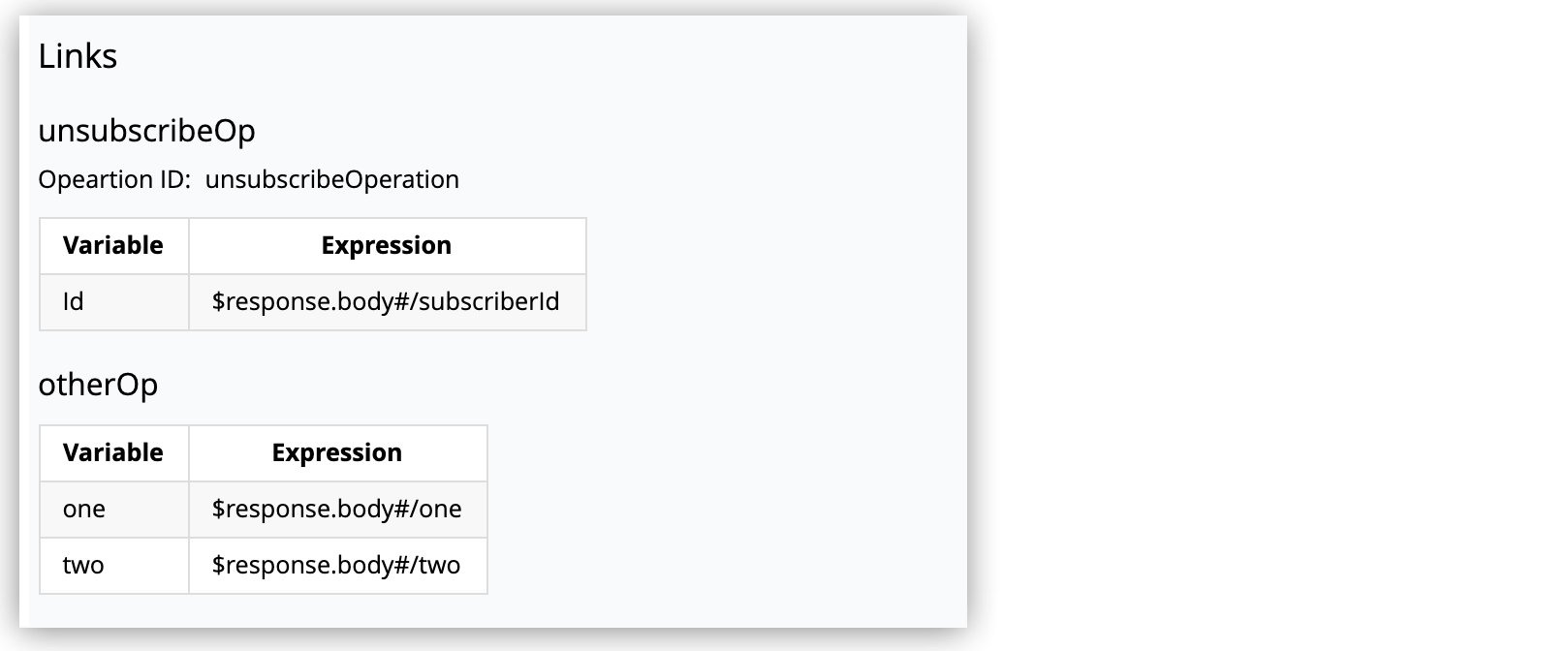
-
The links for the 402 response for the
POSTmethod of the/subscribeendpoint appear at the bottom of the method’s documentation:
The documentation for callouts 3-5 appear in the Callbacks section of the documentation for the POST method of the /subscribe endpoint:




